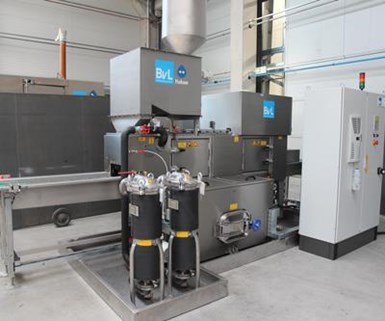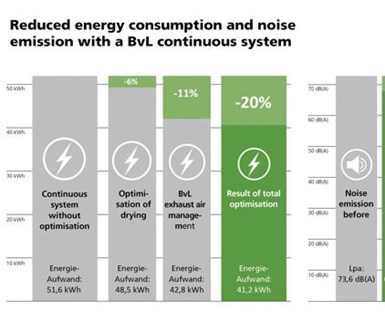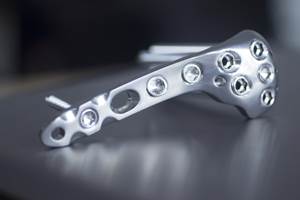Automotive Supplier Capitalizes on Energy Efficient Cleaning
A continuous cleaning system provides excellent cleaning capabilities with short cycle times, as well as a high level of energy efficiency for this automotive supplier.

The Yukon cleaning syste from BvL provides the required results with a clear reduction in energy consumption and nose emission.
Saalfelder Werkzeugmaschinen GmbH (SAMAG) in Germany produces crankshaft bearing caps for a large German automotive manufacturer. For the cleaning of these components, the company not only requires a system that provides excellent cleaning capabilities with short cycle times, but also a high level of energy efficiency.
SAMAG invested in a continuous cleaning system from the manufacturer BvL Oberflächentechnik GmbH in Germany. In the American market, several automotive suppliers have also been using these cleaning systems from BvL in recent years, including ZF Sachs Automotive Méxiko S.A. de C.V in Ramos Arizpe, Mexico, and KSM Castings NC Inc. in Shelby, North Carolina. BvL offers custom solutions through integrated services, from simple washing units, filtration and automated systems to large, complex projects with process monitoring.
Energy Savings
Customized technical measures were installed in the cleaning system for SAMAG to optimize energy consumption and emissions. In addition to insulation on the pipes, optimized drying and the introduction of an automated stand-by state, the cleaning system was equipped with exhaust air management developed by BvL.
The system has now been in operation successfully for more than a year and provides energy savings of 20 percent, compared with a similar system without these energy efficiency measures. Specifically, the savings works out to 10.4 kWh, with the total consumption of the system at only 41.2 kWh instead of 51.6 kWh. Annual CO2 savings is about 41 metric tons. Additionally, water consumption was reduced by a full 20 percent, and noise emissions were decreased by 5 dB(A).

The chart shows energy and noise levels before and after the optimization measures were implemented, as well as individual results of the optimized drying process and the BvL exhaust management.
When BvL presented the options for increasing the energy efficiency of the cleaning systems, SAMAG quickly realized the opportunity to attain their goals. Andreas Weigel, head of maintenance at the SAMAG Group explains that the decision to implement the modifications was easy. “We have a very strong focus on the responsible use of energy resources in our company,” he says. “And of course, we also keep an eye on the total operational costs of a system.” The energy saving package’s amortization period, along with its contributions to environmental protection, made it an attractive option.
BvL implemented several energy saving measures for the system. The central element—exhaust air management—reduces the volume of exhaust air, which consumes the most energy in a continuous cleaning system. To achieve this, the system measures the moisture content in the drying zone and extracts only as much air as necessary for the process. “This creates the best possible moisture level in the system and the volume of hot exhaust air—and therefore energy—blown out of the system is kept as low as possible,” says Peter Stahl, sales engineer at BvL. The warm and moist air, and with it the energy, remains in the system.
Cut the Noise
In addition to energy savings, the requirement specification from SAMAG also limited the noise emissions directly at the discharge zone to 79 dB(A). Mr. Weigel says the sound level measurement was carried out at the measuring positions in line with DIN 45635 part 1 as well as at a “user-related” measuring point defined by SAMAG. According to the DIN measurement, the system achieves a workplace-related emission value of LpA: 68.6 dB(A). A structurally similar system from 2012, without optimization, reached a value of 73.6 dB(A), indicating that the significant noise reduction is because of the optimization measures.
“In the same way, the BvL system achieved a value of 75 dB(A) at the user-related measuring point directly at the discharge position defined by us,” Mr. Weigel says. This value is below the limit value stipulated in the requirement specification. “The reduced noise emission is particularly important in our company, as we are continuously striving to improve the working environment for our employees.”
To reduce noise emissions, the speed of the fan in the drying phase was reduced. Mr. Stahl says the perfect ratio of low flow and high temperature provides an optimum drying result with minimum noise emission.
Wash, Rinse, Repeat
After a year in service, Mr. Weigel says he is absolutely satisfied with the convincing results of the extensive tests and measurements on the cleaning system. The company has not only ordered another system equipped with this energy saving package, but will also retrofit all its BvL cleaning systems with the specially developed energy saving package to increase the energy efficiency of all the production systems.
Related Content
Kyzen Solvents Provide Ease of Cleaning for Medical Parts
The Metalnox line of solvent products are designed to improve reliability and increase the ease of cleaning in vacuum and vapor degreasing processes.
Read MoreOvercoming 3 Common Challenges With Automated Particle Counting
Facing difficulties while performing particle analysis is normal but should not be discouraging. Here are some ways to handle the most prevalent issues that can arise.
Read More3 Common Filtration Questions Answered
Learn about the variety of filters for removing particulates from a cleaning fluid, how to determine cleaning fluid life and more.
Read MoreIndustrial Cleaning Shop Zeros In on Precision
This parts cleaning company is elevating its efforts to become a technical cleanliness expert, which presents an exciting, yet sometimes arduous, journey. The ongoing education of the team as well as significant investments in equipment and processes attribute to this shop’s success.
Read MoreRead Next
A Tooling Workshop Worth a Visit
Marubeni Citizen-Cincom’s tooling and accessory workshop offers a chance to learn more about ancillary devices that can boost machining efficiency and capability.
Read More5 Aspects of PMTS I Appreciate
The three-day edition of the 2025 Precision Machining Technology Show kicks off at the start of April. I’ll be there, and here are some reasons why.
Read MoreEmerging Leaders Nominations Now Open
Here’s your chance to highlight a young person in your manufacturing business who is on the path to be a future leader moving your company forward.
Read More






















